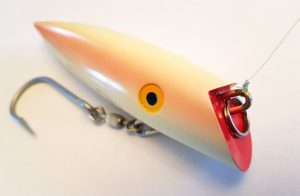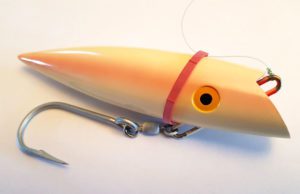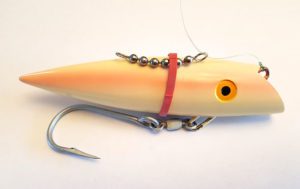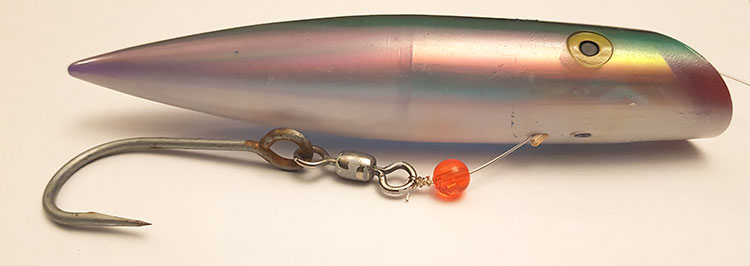Plugs will help you catch salmon right out of the box, but there are a couple of tricks to make them more effective. These tricks focus on Tomic and Tomic-like plugs. What are the different types of setups with fishing plugs? What are the benefits of each setup on the plug? How to hook up more on those shy biters? How fast do you have to troll for the best action of the plug?

First of all, most of these setup instructions are on the Tomic website, including the nose ring, rubber band, bead chain with rubber band, pulling the pin, and double knot rigs. Each setup has its benefits and plug action in the water.
Nose ring setup is a very convenient way to get a little extra action out of the plug. (See Figure 1) You can tie your fishing line on to the nose ring, or you can tie your fishing line on the tow bar and use the nose ring as a noise attraction to the fish. When the plug is swimming in the water with that erratic side-to-side movement, the nose ring will be bouncing around on the lip of the plug creating noise that might attract fish. Fish are curious about noise and vibrations. It triggers a sense of bait in distress or signals a feeding frenzy. If you like quick snaps on your fishing line, the nose ring is an easy and fast way to change plugs.

The rubber band setup is a quick way of making your plug dive downwards more and gives it more erratic up, down, and side-to-side movements straight out of the box. (See Figure 2) With the elastic band setup, you can also troll at slower speeds with the perfect side-to-side action. This is a setup sometimes used in Tyee Club of British Columbia in Campbell River’s annual tournament from July 15 to Sept. 15.
The bead chain with rubber band setup provides the same action as the rubber band setup. (See Figure 3) You just thread your fishing line through the bead chain, then tie your knot on the tow bar of the plug. Now you place the rubber band on top of the bead chain and around the plug. The further you pull the bead chain towards the back of the plug (securing it with the rubber band) the more diving action you will get at slow and fast trolling speeds. The other benefit of the bead chain attached to the plug is that it creates a rattling sound and vibration while the plug is swimming in the water.

Pulling the pin is a very popular setup. (See Figure 4) The full instructions for pulling the pin are on the Tomic website with step-by-step pictures.
With the tow bar removed, you thread your fishing line through the plug and add a bead before tying your knot on to the original swivel hook. The bead before the swivel can help prevent the rough edges of the tow bar holes from weakening your fishing line. This setup gives you the same action as the rubber band setup, but it’s more natural.

You can troll this at slower speeds and achieve the perfect side-to-side plug action in the water. This setup is also popular in the Campbell River Tyee Pool. The benefit of this setup is that if the fishing line breaks, your favorite plug will float to the surface. You can circle around the spot where you lost it and have a chance to get your plug back.

The last setup is tying a double fishing knot on the tow bar. (See Figure 5) This is another simple setup that makes the out-of-the-box plug dive down a little more. Tie an improved clinch knot at the middle of the tow bar tight with 20-pound-test line. Then cut just above the knot you tied. This will be your false knot. Now tie an improved clinch knot with your main fishing line to the tow bar above from the false knot. Then push the false knot against the main fishing line knot close to the top of the plug’s lip. This setup almost has the same action as the nose ring, but without any noise.
All these setups work for those heavy takes when salmon bite close to half of the plug’s length. But what about those shy biters?
Shy biters are salmon that just like to nip at the tail of the plug. With the stock configuration plugs, the salmon must bite half of the plug to get the hook in its mouth. Here are two modified ‘pulling the pin’ setups that will help get those shy biters.
The first method is to have the main fishing line thread through the plug, then put on a bead and tie your hook. Then set your hook.
Now you will get those shy biters that try to nip the tail of the plug. The other way to set the hook back is with beads. (See Figure 4) Place as many plain beads as you would like to adjust how far back the hook will be. The bead method will add some rattling and vibration while trolling. Both of these tricks will get you more successful hookups on the short-takers.
When fishing plugs, the general rule is to troll them fast to get that erratic, frantic action, but not so fast that the plug starts spinning. How do you know what is the right trolling speed? Set your plug in the water 15 feet back from the downrigger clip and drop the cannon ball five feet. Now increase your trolling speed, while looking at the plug, to the point just before it starts spinning like a propeller instead of an up, down, side-to-side action. There is no magic trolling speed; every plug will respond differently because of its weight and design.
So experiment with your plugs, and I hope you get more bites. ![]()






